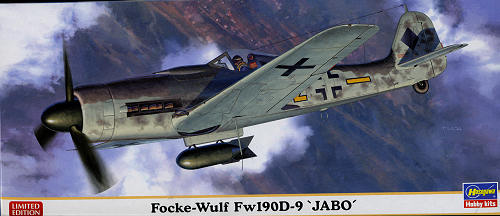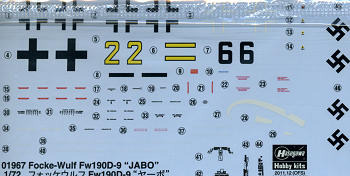
Hasegawa 1/72 FW-190D-9 'Jabo'
| KIT #: | 01967 |
| PRICE: | $27.15 from GreatModels ($33.95 SRP) |
| DECALS: | Two options |
| REVIEWER: | Scott Van Aken |
| NOTES: | Limited reissue |

| HISTORY |
The Fw 190 D (nicknamed the Dora; or Long-Nose Dora, "Langnasen-Dora") was intended to improve on the high-altitude performance of the A-series enough to make it useful against the American heavy bombers of the era. In reality, the D series was rarely used against the heavy bomber raids, as the circumstances of the war in late 1944 meant that fighter-versus-fighter combat and ground attack missions took priority. A total of 1,805 D-9s were produced. Production started in August 1944.
The liquid-cooled 1,750 PS (1,726 hp, 1,287 kW) Jumo 213A could produce 2,100 PS (2,071 hp, 1,545 kW) of emergency power with MW 50 injection, improving performance to 426 mph (686 km/h) at 21,650 ft (6,600 m). Early D-9s reached service without the MW 50 installation, but in the meantime Junkers produced a kit to increase manifold pressure (Ladedrucksteigerungs-Rüstsatz) that increased engine output by 150 PS to 1,900 PS, and was effective up to 5,000 m (16,400 ft) altitude. It was fitted immediately to D-9s delivered to the units from September, or retrofitted in the field by TAM. By the end of December, all operational Doras, 183 in total, were converted. From November 1944, a simplified methanol water (MW 50) system (Oldenburg) was fitted, which boosted output to 2,100 PS. By the end of 1944, 60 were delivered with the simplified MW 50 system or were at the point of entering service. The 115 L tank of the Oldenburg system would hold the MW 50 booster liquid, which was single purpose, while later systems were to be dual purpose, holding either MW 50 or additional fuel.
The fighter lacked the high turn rate and higher rate of roll of its close coupled radial-engined predecessor. It was a bit faster, however, with a maximum speed of 680 km/h (422 mph) at 6,600 meters (21,650 ft). Its 2,240 horsepower with methanol-water injection (MW 50) gave it an excellent acceleration in combat situations. It also climbed and dived more rapidly than the Fw 190A, and so proved well suited to the dive-and-zoom ambush tactics favored by the Schlageter pilots. Many of the early models were not equipped with tanks for methanol, which was in very short supply in any event. At low altitude, the top speed and acceleration of these examples were inferior to those of Allied fighters. Hans Hartigs recalled that only one of the first batch of Dora 9s received by the First Gruppe had methanol water injection, and the rest had a top speed of only 590 km/h (360 mph).
Due to the failure of multiple attempts to create an effective next generation 190, as well as the comments of some Luftwaffe pilots, expectations of the Dora project were low. These impressions were not helped by the fact that Tank made it very clear that he intended the D-9 to be a stopgap until the Ta 152 arrived. These negative opinions existed for some time until positive pilot feedback began arriving at Focke-Wulf and the Luftwaffe command structure.
Sporting good handling and performance characteristics, the D-9 made an effective medium altitude, high speed interceptor, although its performance still fell away at altitudes above about 20,000 ft (6,100 m). When flown by capable pilots, the Fw 190D proved the equal of Allied types.
| THE KIT |
Of course, these kits are not getting less expensive. Thanks to the
general world economy slump and the nearly worthless dollar when compared to the
Japanese Yen, this is not an inexpensive kit to purchase. Even though these
limited run kits seem to sell out rather quickly, if one is frugal and willing
to wait for people to get tired of them and put them on sale, they can be found
at a price approaching what they sold for 15 years ago. Since this is the jabo
version, you get a centerline rack for a large bomb (500kg?) and wing racks for
two smaller ones per wing (50 kg?). I would doubt that a normal mission would
have these planes carrying a complete bomb load so I am thinking either the big
one or the small ones with a drop tank.
Both aircraft have separate windscreen/canopies so you can pose them
open. If you do the later 'blown' hood, you should remember that there was no
antenna tensioning system in it so the radio antenna just lay along the fuselage
when the canopy was open. The decal sheet is well done and appears to be the
modern variety which works great with setting solutions.  This is the
most recent re-issue of the FW-190D-9 done by Hasegawa. Unlike their initial
190D-9 kit, it has the required
engraved panel lines, optional bits for the head rest and canopy, and the
interior that uses decals for instrument panels and side consoles. A drop tank
and rack are also provided. Some 190D-9s were used in the fighter bomber role,
and this kit features bombs and bomb racks (not shown in the sprue shot).Thanks to Hasegawa's
penchant for putting all the bits in one bag, you'll have to be concerned about pieces knocked
off the sprue and bits broken from the wing. I'll leave it
to the rivet counters to tell you if the kit has any accuracy problems, but it
looks just fine to me. This is by no means a complex kit and those who wish to
spruce up the cockpit will find a number of aftermarket sets for it.
This is the
most recent re-issue of the FW-190D-9 done by Hasegawa. Unlike their initial
190D-9 kit, it has the required
engraved panel lines, optional bits for the head rest and canopy, and the
interior that uses decals for instrument panels and side consoles. A drop tank
and rack are also provided. Some 190D-9s were used in the fighter bomber role,
and this kit features bombs and bomb racks (not shown in the sprue shot).Thanks to Hasegawa's
penchant for putting all the bits in one bag, you'll have to be concerned about pieces knocked
off the sprue and bits broken from the wing. I'll leave it
to the rivet counters to tell you if the kit has any accuracy problems, but it
looks just fine to me. This is by no means a complex kit and those who wish to
spruce up the cockpit will find a number of aftermarket sets for it.
 The instructions are well done and typically use Gunze paints for the color
references. Markings are provided for two planes, both of them painted in the
eary 190D scheme of RLM 74/75/76 with mottles in the previous two colors. One is
Yellow 2, a plane featured in the Italeri D-9 kit. This plane is from II./JG 26.
No Reich defense band. The other is black 6 with II./SG10 which mostly flew
190Fs. This one has a yellow band around the nose and a yellow rudder.
The instructions are well done and typically use Gunze paints for the color
references. Markings are provided for two planes, both of them painted in the
eary 190D scheme of RLM 74/75/76 with mottles in the previous two colors. One is
Yellow 2, a plane featured in the Italeri D-9 kit. This plane is from II./JG 26.
No Reich defense band. The other is black 6 with II./SG10 which mostly flew
190Fs. This one has a yellow band around the nose and a yellow rudder.
| CONCLUSIONS |
Still considered one of the best 1/72 FW-190D-9s on the market, this kit gets reissued too infrequently for many. I collect Hasegawa 1/72 190 kits and have now seven D-9 boxings. The first one I have is kit AP 108 from 1994 and prior to this it was the combo kit reviewed just a short time ago after a long drought of 190D-9 boxings. Sure, Academy has one as does Hobby Boss and there are the older Italeri and even older Airfix kits, but most modelers will prefer this one. Get it while you can.
| REFERENCES |
http://en.wikipedia.org/wiki/Focke-Wulf_Fw_190
March 2012
I picked this one up at
GreatModels. Visit them for
great deals all the time. If you would like your product reviewed fairly and quickly, please
contact
me or see other details in the
Note to
Contributors.